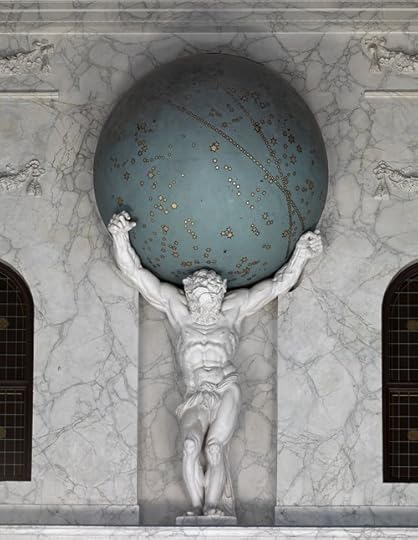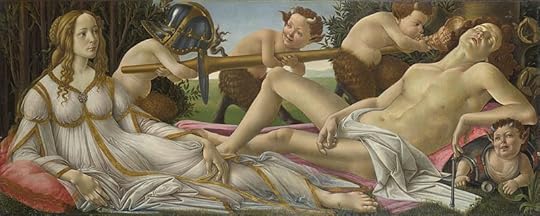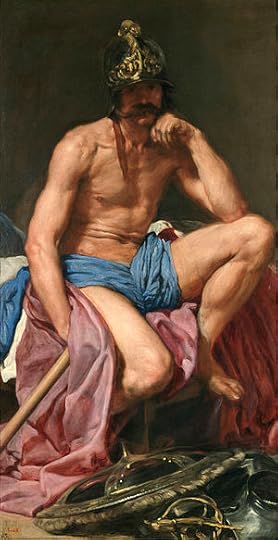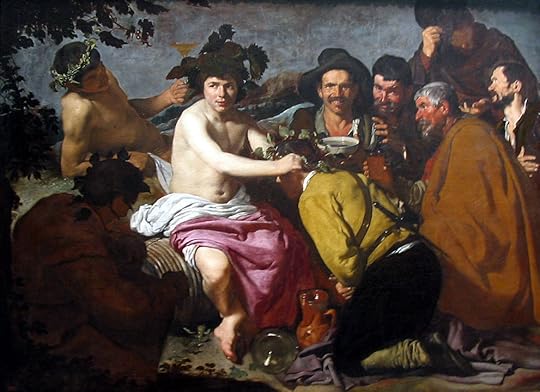 Kalliope’s
Comments
(group member since Aug 28, 2018)
Kalliope’s
Comments
(group member since Aug 28, 2018)
Kalliope’s
comments
from the Ovid's Metamorphoses and Further Metamorphoses group.
Showing 321-340 of 610
 Simpson mentions, as has been said above, the final scenes in the Odyssey, with the battle with the suitors (I may pull out the volume and revisit that section). But it also mentions that it is the 'motivations' and 'vocabulary' that come from the Aeneid (I should have read this before) - from the rivalry between Turns and Aeneas for the hand of Lavinia.
Simpson mentions, as has been said above, the final scenes in the Odyssey, with the battle with the suitors (I may pull out the volume and revisit that section). But it also mentions that it is the 'motivations' and 'vocabulary' that come from the Aeneid (I should have read this before) - from the rivalry between Turns and Aeneas for the hand of Lavinia. Ovid's 'Pentad' [Perseus-Andromeda-Phineus-Cepheus-Cassiope] is to be compared with Virgil's [Aeneas-Lavinia-Turnus-Latinus-Amata].
It is also pointed out that Virgil had 'covered up' the fact that Lavinia was also originally betrothed to the Italian prince Trunus before Aeneas appears on scene.
We are reminded that Cepheus, when he promised to daughter to Perseus, kept very quiet about the fact that she was already betrothed.
 Roman Clodia wrote: "I've only just finished Book 4... Roger, think of the slaughter as an ironic take/commentary on e.g. the Iliad, the war books of the Aeneid etc. Ovid's texts are all about literary games."
Roman Clodia wrote: "I've only just finished Book 4... Roger, think of the slaughter as an ironic take/commentary on e.g. the Iliad, the war books of the Aeneid etc. Ovid's texts are all about literary games."I have now reread the first, gory, section.. The idea of it being a parody is certainly what makes it palatable to 21st century readers.
Thank you, RC, for showing us the light here.
The notes on the Simpson edition further support RC's view.. I will post some of the comments.
But before that, as I am tracking the way the various stories are linked with each other, I am struck by the fact that once again, a story finishes one of the Books to continue in the beginning of the next one. It makes me wonder at how Ovid decided to break the various Books.
 Emma wrote: "I've never listened to this podcast before but they're just starting Metamorphoses so maybe some of you might be interested??
Emma wrote: "I've never listened to this podcast before but they're just starting Metamorphoses so maybe some of you might be interested??http://literatureandhistory.com
Excellent, Emma... Thank you... I did not know about these podcasts.. Look good.
[Sorry if it's already been posted]"
 Roger wrote: "Historygirl has asked me to post the URL for the Medusa Exhibition essay she was really referring to. It is not the online blog, as I thought, but an entire edition of the Met Bulletin, now availab..."
Roger wrote: "Historygirl has asked me to post the URL for the Medusa Exhibition essay she was really referring to. It is not the online blog, as I thought, but an entire edition of the Met Bulletin, now availab..."Thank you, Historygirl and Roger for this...
Perfect...
 My favourite Atlas.. the one inside the Amsterdam Palace, former Town Hall.
My favourite Atlas.. the one inside the Amsterdam Palace, former Town Hall.
One of my treasured plastic folders has this. Nice souvenir.
 It is very quiet here. I have now read the full chapter but very superficially... Still catching up since I have not finished working on Book 4, but hope to come to this one more conscientiously soon.
It is very quiet here. I have now read the full chapter but very superficially... Still catching up since I have not finished working on Book 4, but hope to come to this one more conscientiously soon.
 Fionnuala wrote: "Kalliope, the way Velasquez has left the face of the mustachioed Mars in shadow suggests to me that it might have been a portrait of a real person, but disguised. Could it be a joke/caricature? Of ..."
Fionnuala wrote: "Kalliope, the way Velasquez has left the face of the mustachioed Mars in shadow suggests to me that it might have been a portrait of a real person, but disguised. Could it be a joke/caricature? Of ..."Yes, that is what Jim suggested too... Very tempting idea... but I have never heard anything about this... One consideration against this notion is that the Spanish court at this time (16C and 17C) was VERY hermetic and distant (which even baffled the later Charles I of Britain, when he visited Madrid). But I am not a Velázquez expert.. I will search a bit more...
The painting was not in the king's sleeping quarters but in the 'Torre de la Parada' - a hunting lodge.
The one in sleeping quarters is the Danaë - in the Duke of Wellington's bedroom.
I am including the entry on Mars from the Prado website.
https://www.museodelprado.es/en/the-c...
 Roman Clodia wrote: "
Roman Clodia wrote: "The Romans were generally clean-shaven but Hadrian chose to wear a beard to signify his Greek/Hellenistic allegiances.
..."
That's it, either clean-shaven or with a beard.. but not that moustache. Velázquez knew this, so that is part of his comment on 'Mars'.
 We have forgotten a very famous 'Venus and Mars'
We have forgotten a very famous 'Venus and Mars'Sandro Botticelli. ca 1483. London National Gallery.

Rather than write about it, I will give you the link to a National Gallery presentation.
https://www.youtube.com/watch?v=lm-MF...
The speaker reminds us that Mars is Vulcan's brother.. Ovid didn't warn us about this.
He also says that this is not specifically based on any text - but still relevant to this Book in Ovid.
 Jim wrote: "I find this Velasquez depiction of Mars rather puzzling. Surely a jaded figure; but apart from his humiliation at the hands of Vulcan, he appears to have held his own very successfully. ..."
Jim wrote: "I find this Velasquez depiction of Mars rather puzzling. Surely a jaded figure; but apart from his humiliation at the hands of Vulcan, he appears to have held his own very successfully. ..."Exactly so, Jim. Very puzzling.
But this Mars is not the one in the Ovid narrative - his adventure with Venus and his being caught by Vulcan is not at play here.
There is no narrative, or may be it is just implied by his looking not victorious. He is just the (defeated?) God of War.
The wiki titles him as 'Mars Resting' - for me this is an euphemism.
From a modern viewpoint it has been interpreted as a critical statement on the by then clearly weakening military power of Spain. And the moustache as possibly a quote of the 'Tercios' or elite military corps, in which the soldiers as was the fashion at the time, exhibited such cut. But this is untenable because the painting was made for the King and hung in Royal Hunting lodge.
Enigmatic, again.
 Roger wrote: "Here it is. A group of Mars and Venus in the Louvre, with Mars a portrait of the Emperor Hadrian and the Venus later reworked as a portrait of somebody else. It is not so odd when you see the close..."
Roger wrote: "Here it is. A group of Mars and Venus in the Louvre, with Mars a portrait of the Emperor Hadrian and the Venus later reworked as a portrait of somebody else. It is not so odd when you see the close..."He has a beard, therefore entirely 'classical', even if as you say, the moustache is more prominent.
Thank you for the image, Roger.
 After having watched several times the opera Semele, where Athamas and Ino figure prominently too, it felt strange to see their terrible ending.
After having watched several times the opera Semele, where Athamas and Ino figure prominently too, it felt strange to see their terrible ending.In the Opera, the first act begins with the wedding of Semele to Athamas, and the distressed Ino - and finishes with their becoming a happy couple in contrast to Semele. Juno there is so worried with punishing Semele that the audience would not think that she would then continue her revenge with Semele's sister.
Anticlimatic for me to read this section.
 Roger wrote: "was not about the unity of composition so much as comparative weakness of handling..."
Roger wrote: "was not about the unity of composition so much as comparative weakness of handling..."But that is precisely the point, the handling of Apollo is different, on purpose.. Vz is contrasting different modes of art...
Another of his mythological figures, again, not straight out of Ovid, but one of the characters we meet in this Book.
A defeated Mars this time...
Velázquez. Mars. 1638. Prado.

Not comical like Tintoretto's Mars, but not heroic either.
To me somewhat theatrical too. That moustache is so 'unclassical'.
 Roger wrote: "Velázquez. You say the Apollo is the funny one. Yes, that's exactly what I meant. He seems rather namby-pamby, doesn't he, an outsider that the others would normally chuck out to let them get on with their work....."
Roger wrote: "Velázquez. You say the Apollo is the funny one. Yes, that's exactly what I meant. He seems rather namby-pamby, doesn't he, an outsider that the others would normally chuck out to let them get on with their work....."But one has to think that the contrast was intended. Had he wanted a more fused group, Vz would have done so. His mythology paintings are rarely about the story told in a straight forward way. It seems he is meditating on the arts and crafts and creativity. Vulcan is the artificer - and after Caravaggio the 'idealised' representation in the arts had been turned on its head...
I shall post another one in which he mixes in a funny way the various realms, and since it is Bacchus, it is appropriate for this thread.
Velázquez. The Triumph of Bacchus, or, The Drunkards (Los Borrachos). 1628-29. Prado.

 Roman Clodia wrote: "I'm not on Jupiter's side! Tbh, in my head he gets tangled up with Augustus (king of the gods/emperor, abuse of power and privilege). Are Juno's grievances justified? Her husband is unfaithful but he's the seducer (rapist?) rather than the seduced so taking out her wrath on the innocent, vulnerable, already victimised just doubles the injustice, in my view. We can see power hierarchies in action here: Juno can't punish Jupiter so takes out her spite on those lower than her. .."
Roman Clodia wrote: "I'm not on Jupiter's side! Tbh, in my head he gets tangled up with Augustus (king of the gods/emperor, abuse of power and privilege). Are Juno's grievances justified? Her husband is unfaithful but he's the seducer (rapist?) rather than the seduced so taking out her wrath on the innocent, vulnerable, already victimised just doubles the injustice, in my view. We can see power hierarchies in action here: Juno can't punish Jupiter so takes out her spite on those lower than her. .."I entirely agree.. Jupiter is obnoxious. He is what in Spanish would be branded as 'viejo verde'.
 Roger wrote: "DANAE PAINTINGS. One reason why I wanted to be sure to include Danaë, despite the brevity of her mention, is that the myth has given rise to some of my favorite paintings. The Wikipedia article has..."
Roger wrote: "DANAE PAINTINGS. One reason why I wanted to be sure to include Danaë, despite the brevity of her mention, is that the myth has given rise to some of my favorite paintings. The Wikipedia article has..."I was also looking forward to the textual account of Danaë, because there have been so many beautiful paintings dealing with the subject. So many of the 'top masters' treated it.
I agree that it is crucial, and a differentiating factor, that it is made clear that it is the rain of gold that impregnates her - when it is shown with just rays of light, and she is clothed (like the Gossaert), the composition can get dangerously close to an Annunciation.
My understanding is that Titian's rendition, highly successful as you say since several survive, served as a 'model' to many other painters - whether they chose to follow it or not it was in their minds.
It has been discovered rather recently that the one currently in the Prado was not one of the 'poesie' that Titian painted for Philip II. That one is currently in London in Apsley House. The Royal Collection had two until one was taken away by the French during the War of Independence. The one remaining was purchased by Velázquez in Italy, for Philip IV, and since Vz deemed it superior (looser brush which he favoured), he relegated the Apsley version to a another palace from where it was stolen.
I am off to London in May and was hoping to see the Apsley Danaë but, alas, it is kept in the private area of the Palace (the Duke's bedroom, I understand).
 Desirae wrote: "Roman Clodia wrote: "I've always struggled with understanding the connection between the Minyeides' rejection of Bacchus and their storytelling. Their stories replace their acts of reverence, seemi..."
Desirae wrote: "Roman Clodia wrote: "I've always struggled with understanding the connection between the Minyeides' rejection of Bacchus and their storytelling. Their stories replace their acts of reverence, seemi..."Interesting point... about the Minyeides telling of stories to 'do away with other obligations'. A way of distracting time when there are other distracting things going on - it reminded me of the later Decameron and the telling of stories as a way of buying time in life.
 Roger wrote: "Tintoretto.."
Roger wrote: "Tintoretto.."There is an essay on Tintoretto's version of Venus and Vulcan (and hidden Mars) in On n'y voit rien : descriptions. It is the first essay in the collection, titled 'Cara Giulia'.
Both Fionnuala and I wrote a review on this (I think I read it after I read her review).
Various points:
The drawing did not have Mars hidden.
There was no barking dog telling everyone (Vulcan and us, but Vulcan does not seem to hear it) that there is someone hidden.
In the final painting, the image in the mirror does not correspond Vulcan's position. In the mirrored image Vulcan has both his knees on the bed - and this is different in the drawing). For Arasse this indicates what is going to happen next.
The drawing is in Berlin.

It is a fascinating painting - no other has been found with that kind of composition.
Arasse thinks that it may have belonged to a Gonzaga.
 Roger wrote: "Nonetheless, you have explained it. I knew it wasn't Mars, but didn't realize it was a later episode in the same story
Roger wrote: "Nonetheless, you have explained it. I knew it wasn't Mars, but didn't realize it was a later episode in the same story..."
I would say this episode is early in the story.. We have Apollo telling Vulcan for the first time that he has seen his wife with Mars (they were somewhat silly and should have got together at night, when the Sun was not around as a 'drone' as you say). And so Vulcan sets off to trap the adulterers.
May be the whole thing would start with the couple together (Love-making =>? Peace-making); then the drone discovers them; the drone then goes to the husband and discovers the affair; the wronged husband traps the lovers with his net (he could have just told them a boring story since we are seeing that threads and nets are formulations for story-telling); the whole set of gods and goddesses laugh at the spectacle.
Ovid does not seem to like informers - hence Apollo also gets punished by Venus herself. We saw this in Book II with the Raven and Ocyrhoe.
As for the Velázquez, I disagree with you Roger. I think he has made something a lot more interesting with the same formula that Tempesta used. Vulcan and his colleagues are quite something. Athletic men as Velázquez would have seen them in a tavern, and not in the Olympus. And their reaction to the story they are hearing (and that we can only recite in our head) is quite arresting.
For me the funny one is Apollo.
Another thing to remember about Vulcan - he made the doors of the Palace of Heaven (beginning of Book II. He is an artificer and hence a figure of great interest for artists.

